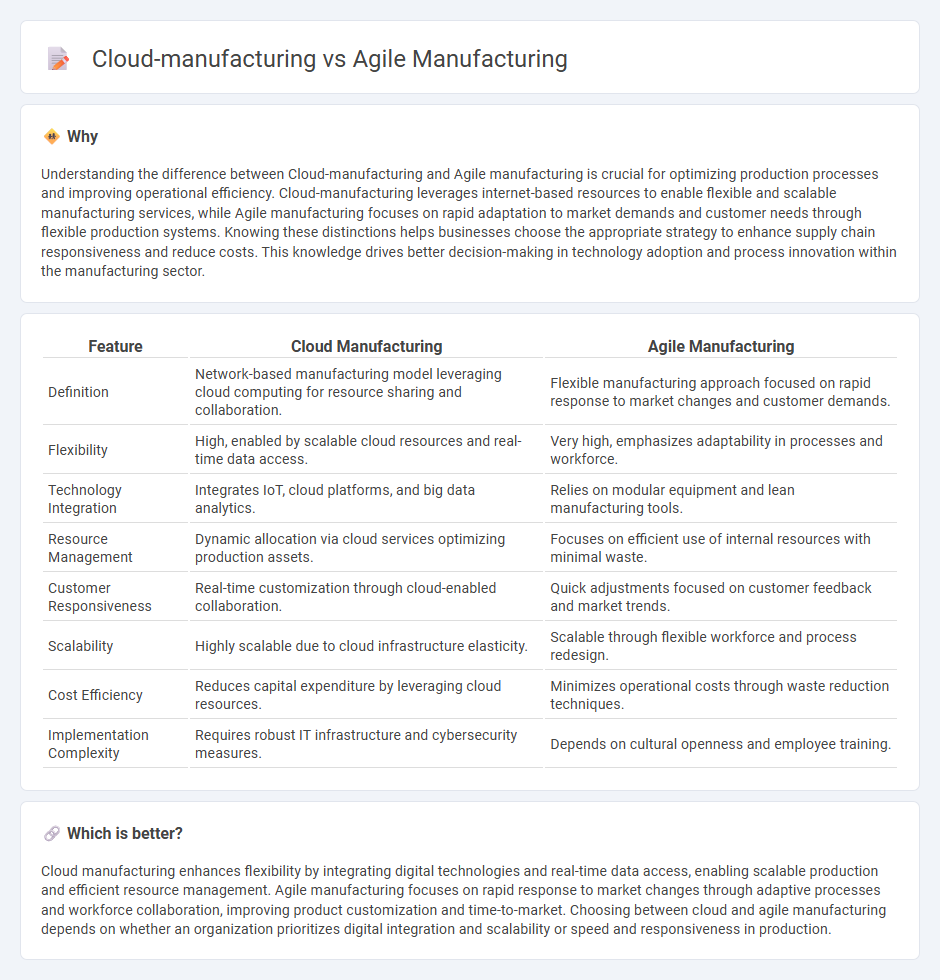
Cloud manufacturing leverages internet-based technologies to create a flexible, scalable production environment that integrates resources and services globally in real-time. Agile manufacturing focuses on rapid response to market changes and customer demands by emphasizing adaptability, collaboration, and lean processes within the factory floor. Explore how combining cloud manufacturing with agile principles drives innovation and competitiveness in modern production.
Why it is important
Understanding the difference between Cloud-manufacturing and Agile manufacturing is crucial for optimizing production processes and improving operational efficiency. Cloud-manufacturing leverages internet-based resources to enable flexible and scalable manufacturing services, while Agile manufacturing focuses on rapid adaptation to market demands and customer needs through flexible production systems. Knowing these distinctions helps businesses choose the appropriate strategy to enhance supply chain responsiveness and reduce costs. This knowledge drives better decision-making in technology adoption and process innovation within the manufacturing sector.
Comparison Table
| Feature | Cloud Manufacturing | Agile Manufacturing |
|---|---|---|
| Definition | Network-based manufacturing model leveraging cloud computing for resource sharing and collaboration. | Flexible manufacturing approach focused on rapid response to market changes and customer demands. |
| Flexibility | High, enabled by scalable cloud resources and real-time data access. | Very high, emphasizes adaptability in processes and workforce. |
| Technology Integration | Integrates IoT, cloud platforms, and big data analytics. | Relies on modular equipment and lean manufacturing tools. |
| Resource Management | Dynamic allocation via cloud services optimizing production assets. | Focuses on efficient use of internal resources with minimal waste. |
| Customer Responsiveness | Real-time customization through cloud-enabled collaboration. | Quick adjustments focused on customer feedback and market trends. |
| Scalability | Highly scalable due to cloud infrastructure elasticity. | Scalable through flexible workforce and process redesign. |
| Cost Efficiency | Reduces capital expenditure by leveraging cloud resources. | Minimizes operational costs through waste reduction techniques. |
| Implementation Complexity | Requires robust IT infrastructure and cybersecurity measures. | Depends on cultural openness and employee training. |
Which is better?
Cloud manufacturing enhances flexibility by integrating digital technologies and real-time data access, enabling scalable production and efficient resource management. Agile manufacturing focuses on rapid response to market changes through adaptive processes and workforce collaboration, improving product customization and time-to-market. Choosing between cloud and agile manufacturing depends on whether an organization prioritizes digital integration and scalability or speed and responsiveness in production.
Connection
Cloud manufacturing leverages distributed computing resources to enhance flexibility, scalability, and real-time data sharing across production networks. Agile manufacturing focuses on rapid responsiveness and adaptability to changing market demands through modular processes and collaborative teams. Integrating cloud manufacturing technologies enables agile manufacturing by providing seamless access to data, facilitating dynamic resource allocation, and supporting accelerated decision-making processes.
Key Terms
Flexibility
Agile manufacturing emphasizes rapid adaptation to changing customer needs through modular processes and real-time decision-making, enhancing production flexibility. Cloud manufacturing leverages distributed cloud computing resources to enable collaborative design and scalable production capabilities across multiple locations. Discover how these innovative approaches revolutionize manufacturing flexibility by exploring their unique features and benefits.
Virtualization
Agile manufacturing emphasizes flexibility and rapid adaptation through lean processes and real-time responsiveness, while cloud manufacturing leverages virtualization to enable resource sharing, scalability, and seamless collaboration over the internet. Virtualization in cloud manufacturing abstracts physical production resources into virtual services, enhancing accessibility and efficiency compared to traditional agile frameworks. Explore how virtualization transforms manufacturing by bridging agility with cloud-based innovation for deeper insights.
Real-time collaboration
Agile manufacturing emphasizes real-time collaboration through flexible, adaptive processes and rapid response to changes in production demands. Cloud manufacturing leverages cloud computing technologies to enable seamless, real-time data sharing and coordination across distributed teams and supply chains. Discover how integrating these approaches can revolutionize manufacturing efficiency and innovation.
Source and External Links
What Is Agile Manufacturing? Lean vs. Agile - This webpage discusses agile manufacturing as a competitive strategy that leverages speed and agility to meet customer demands, often building upon lean manufacturing principles.
Agile Manufacturing: Benefits, Challenges, and Key Technologies - This article provides insights into agile manufacturing, including benefits like responsiveness to customer demand, and highlights Dell as a successful example.
Agile Manufacturing - Wikipedia - This Wikipedia page defines agile manufacturing as a production approach that emphasizes flexibility and rapid response to market changes, closely related to lean manufacturing.
 dowidth.com
dowidth.com